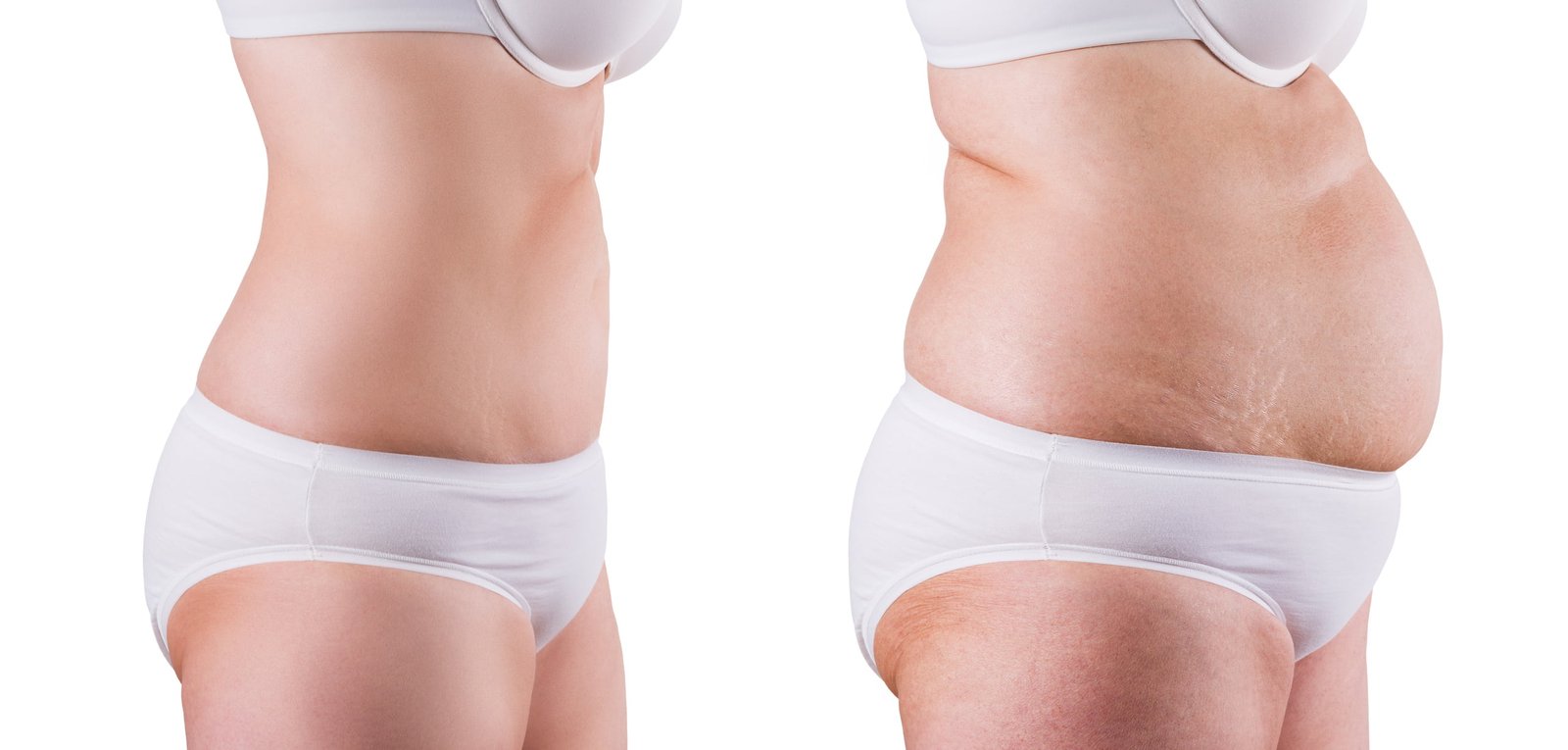Are you struggling to achieve your desired abdominal profile despite maintaining a healthy lifestyle? Are pockets of fat or excess skin keeping you from feeling confident in your own skin?
Dr. K specializes in abdominal wall surgery, including tummy tucks (abdominoplasty procedures), mini tummy tucks, and extended tummy tucks, designed to contour and enhance the appearance of your midsection. He offers personalized treatment plans tailored to the individual needs and goals of each patient, ensuring beautiful and natural-looking results.
What Is a Tummy Tuck?
A tummy tuck surgery, or abdominoplasty, is a surgical procedure that improves the shape and tone of a patient’s abdominal area. It works by removing excess fat tissue, skin, and stretch marks, and tightening the underlying muscles. The result is a smoother and firmer tummy with improved contour and shape.
This plastic surgery procedure is ideal for those who have loose skin and weakened muscles due to aging, pregnancy or drastic weight loss; as well as those with scars on their tummy due to previous injury or surgery.
A tummy tuck surgery offers those looking for improved confidence in their physical appearance a safe way to do so, and can be a great complement to lifestyle changes to maintain a healthy physique.
Benefits
A major benefit of the abdominoplasty is a more youthful and toned midsection, which can lead to improved self-confidence. We all know that looks aren’t everything, but when someone feels good about how they look on the outside, it has a tremendously positive effect on how they feel on the inside.
When the body has undergone a physically traumatic event such as pregnancy or significant weight loss, two things can happen: the abdominal muscles can become strained and even separated, and we are often left with pockets of fat that we cannot remove through regular exercise.
The tummy tuck procedure removes such fat and helps to restore weakened muscles by tightening up your core muscles.
One of the most significant advantages is the restoration of form and function of the abdominal muscles. Often, they can become stretched, weakened, or separated due to pregnancy, weight gain, or aging. A tummy tuck helps to address these concerns by tightening the muscles, resulting in a stronger core.
The procedure can also help to improve the overall shape of the body by removing stubborn pockets of excess fat that may have previously been resistant to diet and exercise. The procedure can provide a more toned and sculpted appearance, which can be especially beneficial for those looking to achieve a more youthful physique.
Following significant weight loss or pregnancy, the skin may not bounce back, and loose skin may hang down from the abdomen. A tummy tuck in Miami can help to remove this excess skin, creating a smoother, tighter, and more toned-looking abdominal area.
Many patients report experiencing improved mental and physical comfort after surgery because they no longer have excess skin hanging from their stomachs, which previously caused chafing or low self-esteem.
Tummy tuck surgery also tends to require less maintenance and revisions down the road. Unlike some other plastic surgery procedures – such as a breast augmentation, where implants are inserted into the body– abdominoplasty sculpts and adjusts your existing natural tissues without introducing foreign objects that may cause complications and revisions down the road.

Types of Tummy Tuck Surgeries
There are different types of tummy tuck surgeries that can be performed, most of which are done under general anesthesia.
1. Mini Tummy Tuck
Mini tummy tuck (partial abdominoplasty) addresses only the lower portion of the abdomen below the belly button, while a full abdominoplasty (tummy-tuck) addresses the entire abdomen above and below the belly-button.
A mini tummy tuck does not require an incision around the navel, and may sometimes be performed while awake under local anesthesia. That said, any repair of stretched or separated muscles would require general anesthesia, whether during a mini or full tummy tuck.
2. Extended Abdominoplasty
Extended abdominoplasty or extended tummy tuck is similar to a regular (full) tummy tuck, but it also targets the flank area between the waist and hips.
This type of technique is best for patients struggling to reduce their love handles and involves a longer incision that extends beyond the hip bones, allowing Dr. Kachniarz to better address the waistline.
3. Circumferential Abdominoplasty
Circumferential Abdominoplasty, also known as a Belt Lipectomy or Body Lift, is an extended abdominoplasty procedure that includes a buttock lift and is commonly performed on patients who have lost a significant amount of weight.
The resulting scar from Circumferential Abdominoplasty runs all the way around the body, which is why this procedure is commonly referred to as a Belt Lipectomy or Body Lift. While this scar may seem extensive, it can be strategically placed to be hidden by most types of clothing.
This procedure both addresses skin and muscle laxity of the abdomen, and also lifts the buttock area. It may be performed in two stages to ease recovery and reduce the length of the procedure.
Surgical Techniques
There are several surgical techniques used in performing a tummy tuck; next we’ll discuss the different surgical techniques.
1. Standard Full Abdominoplasty Technique
The Standard Full Abdominoplasty Technique is the traditional tummy tuck procedure that involves surgically lifting the skin and fat from the abdomen muscles up to the rib cage level.
The stretched or separated abdominal muscles are then carefully repaired, which helps narrow the waistline and reduce any bulging of the abdominal wall. Excess fat and skin is then removed from the lifted tissues, and the incisions closed with dissolvable sutures.
During this time, the belly button is moved to its new location and likewise sutured in place. Although many patients will require drain placement, some procedures are performed without drains.
2. High Lateral Tension Technique
The High Lateral Tension Technique is an advanced modification of the Standard Full Abdominoplasty Technique, which involves vertical-line muscle tightening while keeping the upper abdominal connective tissues attached to the muscles underneath.
This advanced technique is designed to reduce the risk of wound healing complications as it preserves more blood supply to the abdominal tissue. This also allows for liposuction to be performed with the procedure, providing better contouring of the abdomen.
This technique may again be performed either with or without drains, depending on the patient.
3. Avelar Technique
The Avelar Technique is a modified version of the Standard Full Abdominoplasty Technique, designed to offer patients a more precise and efficient way to achieve a flatter, firmer midsection.
This technique involves a combination of muscle tightening, lax skin removal, and liposuction without the use of drains. One of the most notable features of the Avelar Technique is that it only allows for limited loose skin removal.
This means that patients with only a small amount of sagging skin around their midsection can opt for this procedure, avoiding more extensive surgery and tissue removal. However, for patients with a large amount of loose abdominal skin, the traditional Full Abdominoplasty Technique may be more suitable.
4. Floating Abdominoplasty or Fab Technique
The Floating Abdominoplasty or FAB Technique offers unique benefits that set it apart from traditional full abdominoplasty.
The FAB Technique is a form of extended mini abdominoplasty that focuses on targeted and precise shaping of the abdominal area. Unlike the traditional technique that requires a larger incision, the FAB technique uses a smaller incision to remove excess skin.
Muscles are tightened from the sternum to the pubic area, which results in a sculpted midsection and improved waistline contour.
One of the unique benefits of the FAB technique is that the belly button is reattached after the skin tightening. Just like in a mini tummy tuck, this ensures a natural-looking appearance and preserves the original belly button’s shape and appearance without any scarring around the navel.
One of the major benefits over the mini tummy tuck, is that the FAB technique repairs weak abdominal muscles and removes loose skin both above and below the navel. It is a great option for patients with a longer midsection and more limited skin excess.

What Does a Tummy Tuck Surgery Procedure Involve?
The procedure you choose will depend upon your desired outcomes, your body shape and size, and will be discussed with Dr. Kachniarz beforehand. The operation generally takes between 2 and 4 hours, depending on the specific technique used.
During the procedure, loose skin and fatty tissues are first elevated off the abdominal muscles, and a combination of liposuction and/or surgery is used to remove stubborn fat pockets and sculpt the abdomen.
Any stretched or separated muscles are then precisely repaired to improve the waistline contour and any muscle bulging. Once all excess tissues have been removed and sculpted, the remaining skin is pulled tight over the new shape of your stomach before being carefully closed with stitches.
Step-By-Step Breakdown of the Procedure
1. Anesthesia: The patient will be placed under general anesthesia to ensure they are comfortable throughout the procedure.
2. Incision: The procedure begins with an incision in the area between your pubic bone and belly button, well-hidden within the bikini line. Depending on what type of tummy tuck surgery you are getting, the incision may be extended over the hip bones and there may also be an incision around the navel.
The length of the incision may vary depending on the amount of excess skin that needs to be removed.
3. Muscle Tightening: Once the incision has been made, the Dr. Kachniarz will then access the abdominal muscles and use sutures to precisely tighten them.
4. Tissue Removal: After the muscles have been tightened, Dr. Kachniarz will remove any excess skin or fat in the area.
5. Incision Closure: Finally, the incision will be closed with sutures, and the patient will be fitted with compression garments to minimize swelling and bruising during recovery.

Who Is a Good Candidate?
Do you have lax skin that has been stretched due to pregnancy or weight fluctuations, and stubborn pockets of fat that don’t seem to go away no matter how much you diet and exercise?
If you answered yes to any of these questions, then you may be an ideal tummy tuck candidate. A tummy tuck can help to remove excess skin and fat from the abdominal area and tighten the muscles to create a smoother, firmer, and more contoured abdomen.
Sagging skin and weak abdominal muscles are common problems that many people face. These physical conditions can occur from a variety of factors, including drastic weight loss, pregnancy, aging, and genetic factors.
Patients who experience these issues are the prime candidates to receive a tummy tuck procedure to improve their appearance and increase their self-confidence.

Preparing for Surgery
If you’re considering a Miami tummy tuck surgery, it is crucial to prepare yourself for what the procedure entails.
Initial Consultation With Your Surgeon in Miami
The initial tummy tuck consultation with a plastic surgeon in Miami is the first step towards achieving lasting results. When you meet Dr. Kachniarz for the first time, he will take the time to get to know you, understand your medical history, and discuss your goals and expectations for the cosmetic surgery.
The main purpose of the consultation is to determine if you are a good candidate for the procedure. Dr. Kachniarz will evaluate your medical history, current health status, and any medications or supplements you are taking. He will also assess your abdominal muscles, loose skin, and any pockets of extra fat.
During the consultation, Dr. Kachniarz will explain the various types of tummy tuck procedures, including the traditional tummy tuck, mini tummy tuck, and extended tummy tuck, and help you decide which one is best for your needs. He will also discuss the recovery process and provide you with detailed instructions to follow after the surgery.
The consultation is also an opportunity for you to ask questions and express any concerns you may have. Dr. Kachniarz will provide you with honest and realistic expectations for the outcome of the surgery, as well as information about any potential tummy tuck risks and complications.
Things To Consider Before Surgery
Dr. Kachniarz will provide you with pre-operative instructions prior to surgery. These may include fasting from midnight until your operation, avoiding certain medications and supplements, quitting smoking or drinking alcohol, stopping any anti-inflammatory drugs and taking care of any other medical conditions prior to the procedure.
Patients should maintain a healthy lifestyle both before and after their procedure by following a healthy diet rich in vitamins and minerals while engaging in regular exercise like walking or swimming which can help strengthen abdominal muscles post-op.
Risks and Complications of an Abdominal Wall Surgery
A tummy tuck surgery, like any other medical procedure, comes with potential complications and side effects, and it’s important to be aware of all the risks involved before making any decisions.
The most common side effects of abdominoplasty surgery include numbness in the abdomen, sensitive skin, scarring, swelling and bruising. It’s also typical to feel some pain or tenderness following the operation. Each of these symptoms vary from individual to individual, but usually ease up during the first few days of recovery.
Rarer complications associated include infection and wound separation. Wound separation can arise due to delayed healing along the incision, and tends to resolve with proper dressing care. Infections are likewise quite rare, and most improve with a course of antibiotics.
Rare but more serious complications include blood clots and anesthesia-related complications.
To reduce potential complications of cosmetic surgery, it’s advised that patients follow all post-op instructions carefully, and get in touch with their surgeon regarding any concerns. Dr. Kachniarz will fully review any potential risks of the procedure during your consultation.

Recovery Time and Aftercare
It’s important that you have someone who can drive you home after surgery, as well as stay with you overnight should it be necessary. Tummy tuck recovery time varies according to each individual. Generally, most tummy tuck patients are able to return home on the same day as their procedure, though they should expect to take it easy and rest for at least a week following the surgery.
You should expect some swelling and bruising during the recovery period. Wearing a compression garment around your abdomen area during recovery helps to reduce swelling and support healing. It’s also important that patients avoid any strenuous activities or exercise until they are fully recovered, usually around 6 weeks.
It’s also normal to experience some pain and discomfort following the procedure. This can be managed with over-the-counter medications such as ibuprofen or acetaminophen. You may also be prescribed a muscle-relaxant and stronger pain medication to help with the discomfort.
Follow-up appointments with Dr. Kachniarz will be scheduled regularly so that progress can be monitored, and any concerns addressed appropriately throughout the recovery period.
How Much Does a Tummy Tuck Surgery Cost in Miami?
A tummy tuck cost in Miami can range anywhere from $4,000 to $12,000. Fees are all-inclusive and include anesthesia, facility fees, and a surgical garment.
The total tummy tuck costs vary depending on factors such as the location, the type of procedure, and your doctor’s experience.
It is important to understand all associated costs before committing to any kind of aesthetic surgery so that you are aware of what you will be paying in full at each stage of your treatment plan. Health insurance generally does not cover a tummy tuck, as it is considered a cosmetic procedure.
Full Tummy Tuck vs Mini Tummy Tuck
The mini tummy tuck, also known as a partial abdominoplasty, is a less invasive version of the traditional tummy tuck.
A mini tummy tuck is suitable for people who have only a minimal amount of loose skin in the lower abdomen that is localized beneath the navel, whereas a regular tummy tuck procedure addresses skin laxity both above and below the belly button, from the pelvic area to below the ribs.
One of the benefits of a mini tummy tuck is that the incision required is significantly smaller than that of a full tummy tuck, and there is no incision around the navel. This results in a smaller, more minimal scar. Additionally, recovery time for a mini is typically shorter than that of a full procedure, allowing patients to return to their normal activities sooner.
It’s worth noting that a mini tummy tuck may not be suitable for all patients. Those with excess fat and skin throughout the entire abdominal area may require a complete tummy tuck procedure for optimal results.
Alternatives to a Tummy Tuck
Liposuction
Liposuction is one alternative which involves removing fat from the body through small port sites. It can be used on almost any area of the body and is a minimally invasive procedure that does not require incisions or general anesthesia.
While it may not remove as much fat as a full tummy tuck, liposuction can improve contours in areas where diet and exercise have failed to provide desired results. It may also be combined with various non-surgical skin tightening options to improve any mild skin laxity.
CoolSculpting
CoolSculpting is another option; a non-surgical procedure that freezes any unwanted fat cells near the surface of the skin without damaging surrounding tissue or requiring downtime after treatment sessions. It’s been shown to improve skin laxity in treated areas over time, further enhancing overall appearance with continued use.
Ultrasound-assisted liposuction (UAL)
Ultrasound-assisted liposuction (UAL) reduces stubborn pockets of excess fat around the abdomen area that are resistant to traditional weight loss methods like diet and exercise alone.
UAL works by liquefying fatty deposits before they’re removed from the body via suction ports – providing more precision and control during surgery than traditional liposuction techniques allow for.
Can a Tummy Tuck Be Performed in Combination With Other Procedures?
Yes, a tummy tuck procedure can be used with other surgical techniques such as a breast lift surgery, Brazilian butt lift or mommy makeover. Mommy Makeover is a combination of cosmetic surgical procedures designed to help restore a woman’s body after pregnancy.
Pregnancy can leave lasting effects on a woman’s body, especially on the breast and tummy areas. Breast lift, augmentation, or liposuction may also be used as part of the procedure.
By combining procedures, patients can achieve multiple goals in a single surgery. This approach not only saves time and reduces recovery periods, but it can also lower costs. Combining procedures can also ensure that your results are consistent across all treated areas and provide a more comprehensive transformation.
Questions to Ask Your Plastic Surgeon
During an initial consultation with your plastic surgeon, the patient’s medical history, ideal weight, and future pregnancies will be taken into consideration to determine their candidacy for the procedure.
Be sure to ask:
- About any risks that could arise following this type of surgery
- Understand exactly what results can be realistically expected from the operation
- What should you avoid before, during and after surgery
Your tummy tuck surgeon should be able to give you information on post-op recovery and care, possible side effects or complications and pain management techniques, and to advise on follow-up visits after the operation has been completed.

tummy tuck fAQs
Does a Tummy Tuck Leave a Scar?
Scarring is a common concern for many tummy tuck patients. While experienced plastic surgeons like Dr. Kachniarz make every effort to minimize scarring, it is important to understand that some scarring is inevitable.
The horizontal scar is well-hidden within the bikini line, and Dr. Kachniarz uses special flap techniques to minimize the visibility of the belly button scar. Prolonged swelling or bruising may also be experienced by some patients, but these symptoms generally resolve over time.
Can a Tummy Tuck Reduce Scarring of Stretch Marks?
A tummy tuck can help to reduce or eliminate the appearance of stretch marks on the abdomen, depending on their location and amount of skin being removed.
For example, during a complete tummy tuck, all of the skin below the belly button is commonly removed. Any stretch marks along the upper abdomen tend to remain, although the tighter abdominal tissues render them less prominent.
When Will I Be Able To Drive Again After a Tummy Tuck procedure?
Generally, tummy tuck Miami patients should wait until at least two weeks after the surgery before resuming driving. Before getting behind the wheel, patients should also ensure they have stopped taking prescription pain medications.
These medications can affect their reaction time, judgment, and general ability to operate a vehicle.
After undergoing surgery driving requires the use of abdominal muscles, which are likely to be sore and swollen after the procedure. However, the timeline for resuming driving may differ from one patient to another, as each individual’s recovery process is unique.
When Will I Be Able To Do Any Lifting After a Tummy Tuck?
In general, lifting should be avoided for at least six weeks after surgery to allow the abdominal muscles to heal properly. During this time, it’s recommended to refrain from lifting anything heavier than ten pounds.
After six weeks, lifting can gradually be resumed, working up to moderate to heavy lifting over time. However, it’s crucial to listen to your body and not push yourself too hard, as everyone’s recovery process is different. It’s also essential to follow your surgeon’s specific instructions for post-operative care.
Does Insurance Cover a Tummy Tuck?
In most cases, tummy tucks are considered a cosmetic procedure and are not covered by insurance. This means that the cost of the surgery will need to be paid for out of pocket.
It is important to note that there are rare cases where the surgery may be partially or fully covered by insurance. This may occur if the tummy tuck is being performed for medical reasons, such as to treat excess skin that results in pain or persistent rashes.
However, these cases are rare and typically require extensive documentation and medical evidence to support the claim.
References
[1] Mayo Clinic. https://www.mayoclinic.org/tests-procedures/tummy-tuck/about/pac-20384892
[2] National Library of Medicine. https://www.ncbi.nlm.nih.gov/pmc/articles/PMC5621815/
[3] Plastic Surgery. https://www.plasticsurgery.org/documents/News/Statistics/2020/plastic-surgery-statistics-report-2020.pdf



